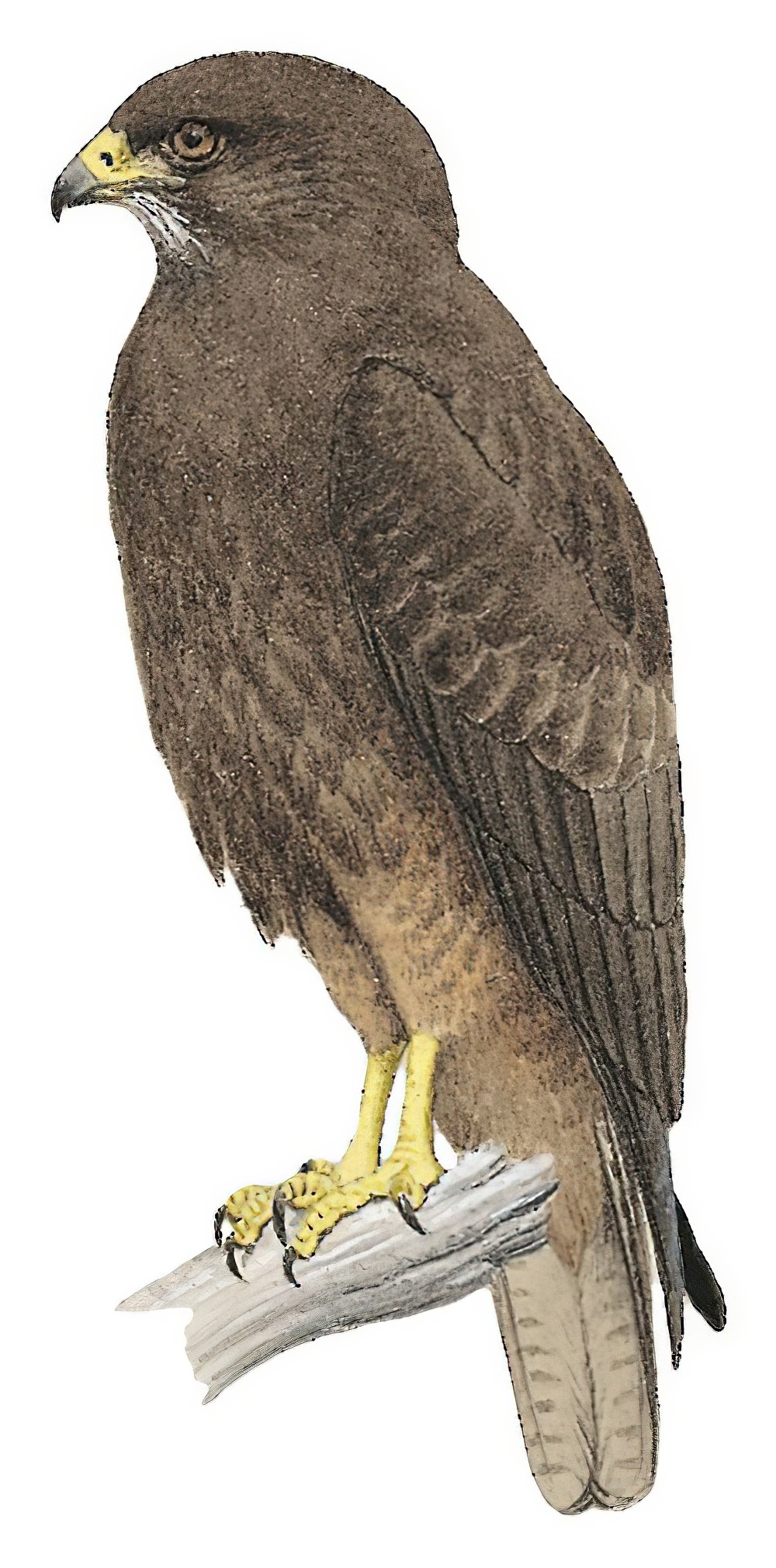Hawaiian Hawk / Buteo solitarius

Hawaiian Hawk
SCI Name:
Protonym: Buteo solitarius U.S.Expl.Exped. 8 p.62
Taxonomy: Accipitriformes / Accipitridae / Buteo
Taxonomy Code: hawhaw
Type Locality: Island of Hawaii.
Author: Peale
Publish Year: 1848
IUCN Status: Near Threatened
DEFINITIONS
BUTEO
(Accipitridae; Ϯ Common Buzzard B. buteo) Specific name Falco buteo Linnaeus, 1758. "BUSE, Buteo. Bec, tête et base du bec des Éperviers; ailes des Aigles; tarse gros et court." (de Lacépède 1799); "Buteo Lacépède, Tabl. Ois., 1799, p. 4. Type, by tautonymy, Falco buteo Linné." (Peters, 1931, I, p. 228).
Var. Bateo, Biteo.
Synon. Amplibuteo, Archibuteo, Asturina, Asturisca, Brewsteria, Butaetes, Butaquila, Buteaetos, Buteola, Buthierax, Cerchne, Circobuteo, Coryornis, Craxirex, Dromolestes, Hemiaetus, Limnaetus, Limnosalus, Onychotes, Poecilopternis, Praedo, Pterolestes, Triorchis.
buteo
L. buteo, buteonis buzzard; "41. FALCO. ... Buteo. 14. F. cera pedibusque luteis, corpore fusco, abdomine pallido maculis fuscis. Buteo vulgaris. Gesn. av. 46. Will. ornith. 38. t. 6. Raj. av. 16. Buteo. Alb. av. I. p. 1. t. 1. Habitat in Europa, Cuniculis & Bufonibus infestus." (Linnaeus 1758) (Buteo).
solitaria / solitaris / solitarius
L. solitarius solitary < solus, solius alone.
● According to Fraser in P. Sclater 1859a, the Solitary Shrike Tyrant was called “el Solitario” by the Spanish settlers of Ecuador (Agriornis).
● ex “Coucou Solitaire” of Levaillant 1806, pl. 206 (Cuculus).
● ex “Green-headed Bunting” of Latham 1785 (syn. Emberiza hortulana).
● “Solitary Sparrow ... It is wont to sit alone on the tops of ancient Edifices and Roofs of Churches, singing most sweetly, especially in the Morning, whence it took its name” (Ray 1678); "95. TURDUS. ... solitarius. 14. T. cæruleus, remigibus rectricibusque nigris, abdomine lineolis cinereis undulato. Passer solitarius. Willugb. orn. 191. Raj. av. 66. Edw. av. 18. t. 18. Olin. av. 14. Act. Ups. 1750. p. 21. Habitat in Oriente. Mas cæruleus; Femina cinerea, subtus lineolis albis & cinereis undulata." (Linnaeus 1758) (Monticola).
● (Statius Müller 1776) ex “Merle solitaire de Manille” of d’Aubenton 1765-1781, pl. 564, fig. 2 (syn. Monticola solitarius philippensis).
● (J. Gmelin 1789) ex “Passera solitaria” of Olina 1622, “Solitary Sparrow” of Willughby 1676, “Passer solitarius” of Ray 1713, “Merula solitaria” of Brisson 1760, “Merle solitaire” of de Buffon 1770-1783, and “Solitary Thrush” of Latham 1783 (syn. Monticola solitarius).
● ex “Suirirí chorreado todo” of de Azara 1802-1805, no. 196 (Myiodynastes).
● ex “Solitaire” of Leguat 1708, and de Buffon 1770-1783, and “Solitary Dodo” of Latham 1785: “not met with in flocks, scarcely more than two being found together” (‡Pezophaps).
● ex “Solitary Parrot” of Latham 1787 (Phigys).
● ex “Japú negro” of de Azara 1802-1805, no. 58 (Procacicus).
● ex “Oiseau Solitaire” of Carré 1669, and “Solitaire” of Dubois 1674 (this bird was formerly thought to be a species of dodo Raphus) (‡Threskiornis).
● ex “Ynambú Mocoicogoé” of de Azara 1802-1805, no. 332 (Tinamus).
● "This new species inhabits the watery solitudes of our highest mountains during the summer, from Kentucky to New York" (A. Wilson 1813) (Tringa).
UPPERCASE: current genus
Uppercase first letter: generic synonym
● and ● See: generic homonyms
lowercase: species and subspecies
●: early names, variants, mispellings
‡: extinct
†: type species
Gr.: ancient Greek
L.: Latin
<: derived from
syn: synonym of
/: separates historical and modern geographic names
ex: based on
TL: type locality
OD: original diagnosis (genus) or original description (species)












